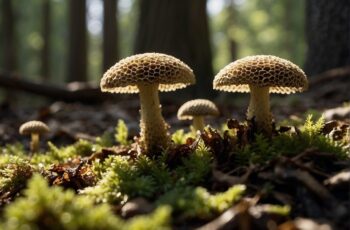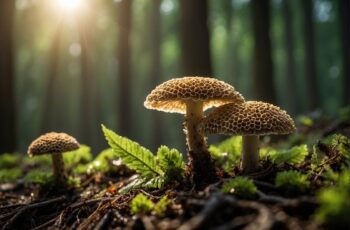Morel mushrooms are a highly sought-after delicacy, known for their unique taste and distinct appearance. As you explore the world of morel mushrooms, it’s essential to understand the critical role that spores play in their life cycle. These microscopic particles are crucial for their reproduction and growth, and understanding their characteristics can help you better appreciate the complexity of these fascinating fungi.
Spores are released by morel mushrooms as a means of propagation, and their dispersal in the wild remains a subject of ongoing scientific inquiry. In general, morel spores have thin walls, which allows them to disperse effectively in their environment. This dispersal method enables morel mushrooms to colonize new areas and thrive in various conditions, including healthy forests, burned areas, and regions damaged by insects.
As you delve deeper into the captivating realm of morel mushrooms, keep in mind the significant role that spores play in their success and adaptability. Armed with this knowledge, you can better appreciate the intricacies of these highly prized culinary delights.
Morel Mushrooms and Their Spores
Understanding Morel Mushroom Spores
Morel mushrooms are a highly sought-after delicacy for their unique taste and texture. A part of the Morchella genus, these mushrooms produce microscopic spores, which play a crucial role in their reproduction. When the conditions are right, these spores germinate and grow into the fruiting body, known as the morel mushroom. As a mushroom enthusiast, it’s essential for you to comprehend how these spores function to better identify and cultivate morel mushrooms.
Morel spores are dispersed through natural elements like wind and rain, and can sometimes travel great distances. It’s worth noting that the exact mechanism of spore dispersal in morel reproduction remains an open question. However, it’s clear that these spores are crucial to their life cycle and the formation of new fruiting bodies.
Morchella Species
The Morchella genus consists of various species of morel mushrooms. Each species has slightly different spore characteristics, habitat preferences, and seasonal appearance. Some of the common Morchella species to look out for when foraging or cultivating include:
- Morchella esculenta: Also known as the yellow morel, this species has yellowish-brown ridges with a honeycomb-like appearance and a hollow stem.
- Morchella elata: Commonly known as the black morel, this species features dark ridges and pits, a more elongated shape, and a preference for burned or recently disturbed areas.
- Morchella americana: Another variety of the yellow morel, this species has a more rounded cap and larger pits compared to Morchella esculenta.
Knowing these different Morchella species will not only improve your foraging skills, but also help you better understand the spore characteristics and habitats required for successful cultivation.
False Morels
As you explore the world of morel mushrooms and their spores, it’s essential to be aware of false morels. These potentially toxic mushrooms closely resemble true morels, but they have a few distinguishable features. Some common false morel species include Gyromitra esculenta, Gyromitra caroliniana, and Verpa bohemica. When foraging for morels, keep in mind these differences between true morels and false morels:
- True morels, such as Morchella spp., have hollow stems and completely attached caps.
- False morels often have a cottony or solid interior, and their caps might be only partially attached to the stem.
Being familiar with the differences between true and false morels can help you avoid picking mushrooms that are potentially harmful or even lethal. By learning about morel mushroom spores, Morchella species, and false morels, you can become more knowledgeable when it comes to identifying, cultivating, and enjoying these delicious fungi.
Growing Morel Mushrooms
Indoor Growing Techniques
To grow morel mushrooms indoors, start by selecting a suitable growing medium, such as a mixture of wood chips, peat moss, and compost. Next, sterilize your growing medium and inoculate it with morel mushroom spawn. Ensure you provide the ideal growing conditions, including temperature, moisture, and light. Maintain a temperature range of 65-75°F, and keep the growing medium consistently moist. Be patient, as it may take a few weeks for the mycelium to colonize the medium completely.
Outdoor Growing Methods
To grow morel mushrooms outdoors, choose a location with loamy or sandy soil near hardwood trees, where morels can take advantage of the trees’ shade and nutrients. You can purchase morel spore slurry or create your own by mixing morel mushroom spores with water and some organic material. Pour the spore slurry onto the prepared growing area, and cover it with a thin layer of wood ash or hardwood chips. Keep the area moist and shaded, and wait for the mushrooms to emerge. They may not appear in the first year, but the established colony can produce mushrooms for several years.
Using Morel Mushroom Spore Kits
A morel mushroom spore kit is a simple way to grow your own morel mushrooms at home. These kits typically contain sterilized growing medium, morel spores, and sometimes additional nutrients. Simply follow the instructions provided with the kit, which usually involves inoculating the growing medium with the spores and maintaining the appropriate temperature, moisture, and light conditions. Be patient, and monitor your kit regularly for signs of mycelial growth and fruiting-body development.
Establishing a Morel Patch
A morel patch can be established in your backyard or garden by following these steps:
- Choose a location with adequate shade, decaying wood, and sandy or loamy soil.
- Prepare the area by removing any weeds or grass and loosening the soil.
- In the early spring or fall, spread a layer of hardwood chips or compost over the prepared area.
- Inoculate the growing area with a morel spore slurry or purchased morel spawn.
- Keep the area moist and shaded, and wait for the mushrooms to emerge.
Remember that establishing a morel patch may take time and patience, as the mushrooms could take several years to appear. However, once the morel colony is established, you will have a source of delicious morel mushrooms for years to come.
Finding and Harvesting Morels
Hunt and Forage for Morel Mushrooms
To successfully hunt and forage for morel mushrooms, you should search during their peak season, which is mainly in the spring. Be prepared for some legwork, as morels can be elusive and require patience. When searching, keep an eye out for mature fungi, as they are more likely to release spores necessary for propagation.
Identifying Ideal Habitats
Morel mushrooms can be found in various habitats, but they particularly thrive in the vicinity of deciduous trees. Pay close attention to tree roots and areas where wild mushrooms naturally grow. Forest fires also create ideal conditions for morels, so consider exploring the areas around burned or young trees. In addition, these fungi often grow in shaded areas with ample moisture.
Harvesting Techniques
To harvest morel mushrooms, use a sharp knife to cut the stem just above the ground, ensuring that no dirt is attached. By leaving the root system intact, you give the fungus a chance to regenerate. Be aware of the temperature, as morels tend to grow better in warmer conditions. Also, only harvest mature mushrooms, as they hold the spores that will allow for future growth.
Cleaning and Storing Morels
After harvesting your morel mushrooms, it’s essential to clean them properly to avoid bacterial contamination. Gently brush off any dirt and debris with a soft brush or damp cloth, and avoid soaking them in water. Once cleaned, store your morels in a paper bag or a well-ventilated container in the refrigerator for up to a week. If you plan to plant morel mushrooms in your garden, you can introduce them to your vegetable plots or other areas with partial shade and consistent moisture.
Morel Mushroom Culinary Uses and Tips
Culinary Benefits of Morel Mushrooms
Morel mushrooms are highly prized for their unique, delicious flavor and are considered a gourmet food. They are an edible mushroom with a distinct, honeycomb-like appearance, being hollow inside. Morels also contain antioxidants, contributing to their nutritional value. However, they can be difficult to find and come with a higher price tag compared to other mushrooms.
Preparing and Cooking Morels
When it comes to cooking morel mushrooms, follow these tips to make the most of their incredible taste:
- Clean morels thoroughly: Since they have a honeycomb pattern, morels can harbor dirt and debris. Gently rinse them under cool water or use a soft brush to remove any unwanted particles.
- Slice them in half: Cutting the morels in half ensures even cooking and allows you to inspect them, ensuring they are not housing any insects.
- Dry sauté the morels: Place the sliced morels in a hot, non-stick pan without oil or butter. Cook them gently, allowing their natural moisture to evaporate. This will help to concentrate their unique flavor.
- Add healthy fats: Once the morels have released their moisture, add a small amount of butter or olive oil to enhance their taste and texture. Sauté them until they are tender.
- Season to taste: Use salt, pepper, and herbs to add flavor to the dish. Morels pair well with thyme, parsley, and chives.
Storing and Preserving Morels
Since morel mushrooms can be difficult to find and may have a limited season, it’s essential to store and preserve them properly:
- Fresh Morels: If you have fresh morels, store them in a paper bag in your refrigerator for up to a week. This will help maintain their moisture and prevent them from drying out too quickly.
- Drying Morels: To preserve morels for a longer period, you can dry them. Slice the morels in half and place them on a drying rack or a baking sheet. Set them in a warm, dry place with good air circulation, and let them dry for a few days. Once dried, store them in an airtight container in a cool, dark place. To rehydrate dried morels, simply soak them in warm water or broth until plump and tender, and then use them as you would fresh morels.
- Freezing Morels: Another method to preserve morels is by freezing them. First, clean and slice the morels. Sauté them in a little butter or olive oil until they are tender. Once they have cooled, place the cooked morels in an airtight container or freezer bag, and store them in the freezer for later use.
Known Challenges and Considerations
Difficulties in Cultivating Morels
Cultivating morel mushrooms (Morchella spp.) can be quite challenging, as they are an elusive species that are not easily grown by gardeners. One major challenge is getting them to grow from mushroom spawn, as there is no guarantee that the spores will successfully produce mushrooms. To increase your chances, it is important to create the right environment, which can involve using a substrate like peat moss, sand, and regularly watering with rainwater. Additionally, maintaining a uniformly shaped patch and covering with a cheesecloth can help protect the developing mushrooms.
Understanding False Morels
It is vital to be aware of false morels when mushroom hunting, as these can be toxic and dangerous for consumption. False morels are mushrooms that resemble the true Morchella species, but they lack some key characteristics that can be used to differentiate them. Be cautious and double-check your findings to ensure you have not encountered a false morel.
Mushroom Pests and Contamination
Mushroom pests and contamination can pose significant challenges for both cultivating morels and harvesting them in the wild. Some common pests include slugs and insects that feed on the mushrooms, potentially reducing the yield or quality of your harvest. To reduce the risk of contamination, it is essential to keep your cultivated morel patch clean, preventing the introduction of harmful bacteria or fungi that could harm the mushrooms or make them unsafe for consumption. Regular monitoring, upkeep, and maintaining a clean environment in your cultivation area are critical in addressing these challenges.


